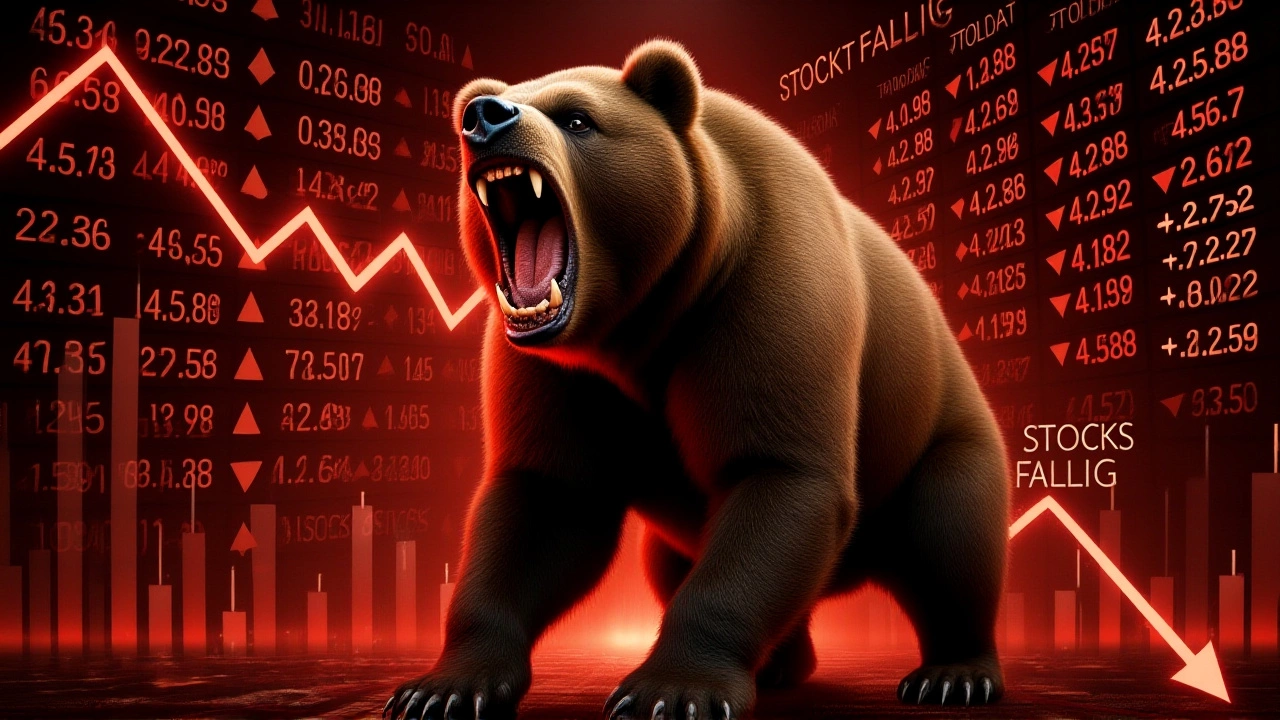Trump Tariff Shock Sends Indian Stock Market Plummeting in Late Sep‑Oct 2025

When Donald Trump, former U.S. President, unveiled a 100 % tariff on branded drug imports and a $100,000 levy on new H‑1B visas, investors in India saw their portfolios melt faster than ice on a summer sidewalk. The Indian stock market slid for eight straight sessions in late September and early October 2025, wiping out roughly ₹16 lakh crore in market value and pushing the BSE Sensex below 80,400 and the NSE Nifty50 under 24,650. The fallout was felt across pharma, IT, and financial services, while foreign institutional investors dumped shares worth ₹2,425.7 crore.
Background: A rally turned fragile
Earlier in 2025, Indian equities had been on a tear. The Sensex surged past 82,000 in August, buoyed by a strong GDP reading and a 0.5 % GST cut. Analysts at Motilal Oswal noted that the Nifty climbed from 24,400 to 25,400 in just three weeks, a move that left momentum indicators screaming overbought. Yet the rapid ascent left little cushion for any shock, and the market was already wobbling under inflation pressures and a tightening global monetary stance.
Timeline of the September‑October sell‑off
September 19 marked the first crack. After three days of gains, the Nifty slipped to 25,286 and the Sensex to 82,485 as traders booked profits. Stocks advancing on the BSE numbered 1,984, while 1,929 fell – a near‑even split that signaled widening unease. By September 25, the market entered its fifth straight losing day, nudging the Nifty below the 24,900 mark and setting the stage for the larger plunge.
U.S. policy shocks: tariffs and the H‑1B visa fee
Late September brought the double whammy. On a Friday – September 26 – Trump announced a 100 % tariff on patented drug imports, slated to kick in on October 1. The pharma sector instantly reacted: the Nifty Pharma index dived 2.7 %, or 590 points, to a low of 21,390.25. Companies such as Laurus Labs, Zydus Lifesciences, Natco Pharma, and Biocon each shed up to 7 % in a single session.
Just days earlier, Trump had also unveiled a $100,000 fee on new H‑1B visa applications, a move that rattled the IT crowd. The Nifty fell 112 points to 25,056 and the Sensex dropped 386 points to 81,715, extending the loss streak to four days. Pankaj Pandey, head of fundamental research at ICICI Direct summed it up: "The visa fee announcement soured sentiment, even though tier‑1 IT firms may only see a 1‑2 % profit hit. The market is reacting to fear, not fundamentals."
Foreign institutional flows and domestic response
Foreign Institutional Investors (FIIs) turned sharply negative, net‑selling ₹2,425.7 crore over the week. Domestic institutions stepped in, buying ₹1,211.7 crore, but the foreign outflow signaled a loss of confidence in Indian equities amid global turbulence.
Ruchit Jain, vice‑president at Motilal Oswal Financial Services warned: "Technicals were screaming overbought before the U.S. policy surprise. The market was overdue for a correction, and the tariff news was the catalyst."
Sectoral fallout: pharma, IT, and financial services
The pharma hit was the most visible, but IT stocks also felt the pinch as the H‑1B fee threatened hiring pipelines. Meanwhile, the financial services index, which had bounced 9 % in March, erased those gains as risk appetite faded. Banks reported tighter credit spreads, and insurers saw premium growth expectations slide.

Policy reaction: RBI, SEBI, and government measures
The Reserve Bank of India (RBI) stepped in to steady the rupee, deploying foreign exchange reserves to curb volatility. Simultaneously, the Securities and Exchange Board of India (SEBI) imposed temporary circuit‑breaker limits on futures contracts to dampen excess gyrations.
Sources close to the finance ministry said the government was weighing a modest stimulus package – possibly a targeted tax rebate for exporters – to revive confidence, though no formal announcement had been made by early October.
Alternative assets surge: gold and silver rally
With equities under pressure, investors fled to safe‑haven metals. Domestic gold prices leapt more than 47 % year‑to‑date, hovering around ₹1,12,300 per 10 g, while silver surged 58 % to roughly ₹1,34,200 per kg. In dollar terms, gold rallied to $3,750 per ounce, its highest since 2022, and silver touched $44.2 per ounce. The bullion boom lifted trading volumes on the MCX by a record 32 % in the week of October 2.
What’s next? Outlook for the second half of 2025
Analysts expect the market to test the 24,200 support level on the Nifty. A breakout below could trigger further foreign outflows, especially if U.S. trade negotiations stall. Conversely, any sign of easing in U.S. tariff policy or a clear Indian fiscal stimulus could spark a short‑term bounce.
Frequently Asked Questions
How will the 100 % drug tariff affect Indian pharma exporters?
The tariff makes Indian‑made patented medicines effectively twice as expensive in the U.S. market, slashing profit margins for exporters like Laurus Labs and Zydus Lifesciences. Analysts project a 5‑10 % revenue dip for top exporters in FY 2026, unless they pivot to non‑patented generics or diversify into emerging markets.
What impact does the H‑1B visa fee have on Indian IT companies?
The $100,000 fee raises the cost of hiring fresh talent from India, potentially slowing project pipelines for firms that rely on U.S. contracts. Short‑term earnings hit is expected to be modest – around 1‑2 % – but the psychological impact has already dented share prices.
Why did foreign institutional investors sell aggressively?
FIIs reacted to the twin U.S. policy shocks and a broader weakness in Asian equity markets – Japan’s Nikkei fell 0.9 %, Hong Kong’s Hang Seng 1.4 % – fearing a spill‑over effect. The net outflow of ₹2,425.7 crore reflected a shift toward safer assets like U.S. Treasuries and gold.
What role did the RBI and SEBI play in calming the market?
The RBI used its foreign‑exchange reserves to provide liquidity and support the rupee, preventing a sharp depreciation. SEBI introduced temporary circuit‑breaker thresholds on futures contracts, curbing extreme intraday swings and giving traders a breather.
Will gold and silver keep rising as equities stay weak?
Precious metals have benefited from the risk‑off sentiment, with gold up 47 % and silver up 58 % YTD. If equity volatility persists and inflation stays high, the metals rally could continue, but any clear resolution of U.S. trade tensions might shift capital back to stocks.